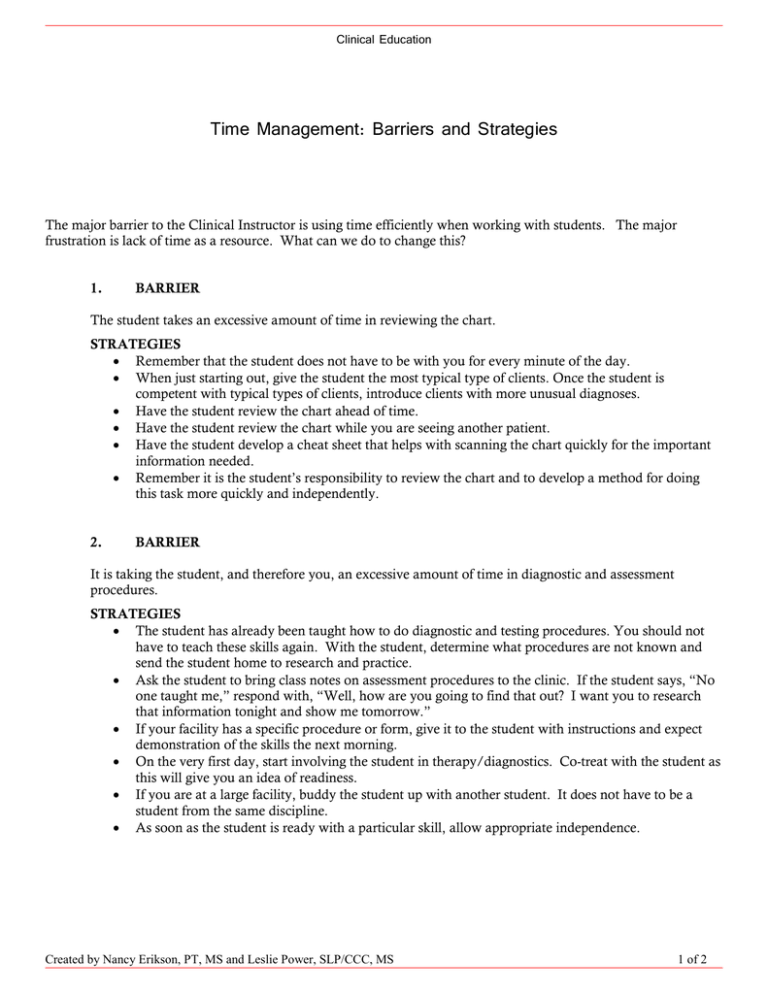Time Management Barriers and Strategies
advertisement

Clinical Education Time Management: Barriers and Strategies The major barrier to the Clinical Instructor is using time efficiently when working with students. The major frustration is lack of time as a resource. What can we do to change this? 1. BARRIER The student takes an excessive amount of time in reviewing the chart. STRATEGIES Remember that the student does not have to be with you for every minute of the day. When just starting out, give the student the most typical type of clients. Once the student is competent with typical types of clients, introduce clients with more unusual diagnoses. Have the student review the chart ahead of time. Have the student review the chart while you are seeing another patient. Have the student develop a cheat sheet that helps with scanning the chart quickly for the important information needed. Remember it is the student’s responsibility to review the chart and to develop a method for doing this task more quickly and independently. 2. BARRIER It is taking the student, and therefore you, an excessive amount of time in diagnostic and assessment procedures. STRATEGIES The student has already been taught how to do diagnostic and testing procedures. You should not have to teach these skills again. With the student, determine what procedures are not known and send the student home to research and practice. Ask the student to bring class notes on assessment procedures to the clinic. If the student says, “No one taught me,” respond with, “Well, how are you going to find that out? I want you to research that information tonight and show me tomorrow.” If your facility has a specific procedure or form, give it to the student with instructions and expect demonstration of the skills the next morning. On the very first day, start involving the student in therapy/diagnostics. Co-treat with the student as this will give you an idea of readiness. If you are at a large facility, buddy the student up with another student. It does not have to be a student from the same discipline. As soon as the student is ready with a particular skill, allow appropriate independence. Created by Nancy Erikson, PT, MS and Leslie Power, SLP/CCC, MS 1 of 2 3. BARRIER The student is taking an excessive amount of time in taking the history from the client. STRATEGIES Make sure the student has a watch and is wearing it. Have the student write down the pertinent questions during the chart review. This probably does not need to be supervised. Give a time expectation. “You have 5 minutes.” Give the student permission to re-direct the client when history taking. Make sure that the student has a notebook or clipboard. Encourage the student to take notes on questions and expect answers the next day. Do not feel that the student needs to be with you every moment. If you have watched the student before and competence was demonstrated, encourage independence with the history taking. If the student needs practice, require teaming up with another student. 4. BARRIER The student is taking an excessive amount of time in coming up with the therapy plan. STRATEGIES Let the student come up with a plan independently, and then you refine it. Have the student write out the plan. As part of the written plan, require the student to prioritize the objectives and estimate the time it will take for each one. Allow the student some planning and thinking time while you do something else. Ask the student to explain how therapy leads to a functional goal. Ask the student what equipment is needed for the treatment and then make the student responsible for having it. Ask: “Might there be something else that you will need?” Have the student write down alternate plans just in case something does not work. 5. BARRIER The student is taking an excessive amount of time with the paperwork/charting. STRATEGIES After observing a session, have the student practice writing the chart notes while you are writing your entry. Then have the student compare the two notes while you move on to something else. Have the student time how long it takes to write a note and then set goals for a time limit. After treating a patient, leave the student alone to write the note outside of the chart. Then review it later and have the student write it in the chart. Have the student develop a list of functional goals and objectives for particular diagnoses. Have the student do a self- assessment of the treatment session, including charting. Have your student work with another student for peer review. It does not necessarily have to be a student from the same discipline. Created by Nancy Erikson, PT, MS and Leslie Power, SLP/CCC, MS 2 of 2





